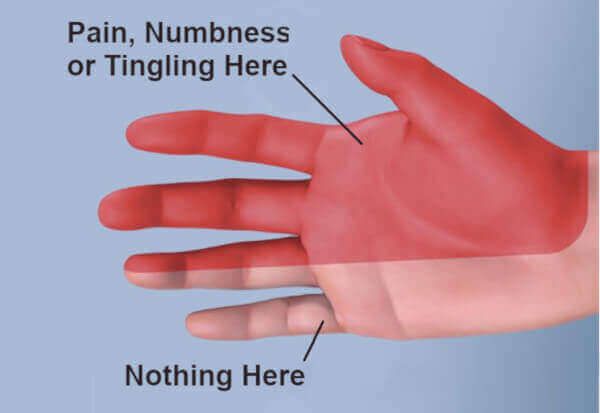Signs of Carpal Tunnel Syndrome & Tendinitis
Table of Contents
- Overview
- Other conditions have similar signs
- Signs of carpal tunnel syndrome
- How carpal tunnel begins
- As carpal tunnel progresses
- Signs of wrist tendonitis
- Why you get tendonitis
- What tendonitis feels like
- If you have signs of either condition
- Summary
- FAQs
- About
Overview
The signs of carpal tunnel syndrome & tendinitis of the forearm can be similar. Both can cause hand or finger
pain,
numbness, tingling, burning, aching, and weakness. This article tells you how to identify the symptoms of each condition. It's the first step in tackling the problem. Then can you properly treat the disorder you have. (How you can treat
carpal tunnel and
tendonitis is the subject of another article.)
Other conditions have similar signs
The signs of carpal tunnel syndrome & tendonitis of the forearm (or wrist tendonitis) can be so similar that they even fool doctors. In fact, tendinitis is often
misdiagnosed as carpal tunnel syndrome 80% of the time.
Another similar hand disorder,
de Quervain’s tenosynovitis is also often confused as wrist tendonitis. But de Quervain’s tenosynovitis only affects the thumb tendons. It also usually only produces pain when moving your thumb.
Even though the signs of carpal tunnel syndrome & tendonitis may be similar, they are medically
very different conditions. Their symptoms are similar only because they share a common factor: tendon inflammation.
Scientists believe that either condition comes as a result of
repetitively stressing your hand. Consequently, tendons inflame and swell. But the similarities between carpal tunnel syndrome and wrist tendonitis end there.
It's important to note that every person is different and will experience symptoms and warning signs differently. Also, some people can have
BOTH conditions at the same time. So be familiar with the primary signs and symptoms of each disorder.
Signs of carpal tunnel syndrome
How carpal tunnel begins
Usually carpal tunnel syndrome results from repetitively straining your hands for a long time. But that’s not a rule. Scientists believe that no matter how much you stress your hand, you’re either prone to getting carpal tunnel or you’re not.
But it’s clear that if you have the tendency to get carpal tunnel, stressing your hand will help bring it on. Your daily activities play a big role in your risk of getting carpal tunnel. Certain
harmful hand activities are known to cause carpal tunnel. In fact, there are particular
jobs causing carpal tunnel you should be familiar with. for instance, hair styling & carpal tunnel are a very common problem seen in a doctor's office.
You can perform a simple
carpal tunnel test on yourself to determine if you have this condition. It’s highly reliable. And it’s the very same test hand specialists use in their office.
As carpal tunnel progresses
Generally, the warning signs and symptoms of carpal tunnel follow a specific pattern. As symptoms become more
severe they might be completely different for you compared to somebody else.
- Usually, symptoms begin with mild
numbness or tingling in the fingers or palm – but never in the little finger. Most times the thumb and forefinger are worse. Sometimes pain is the first symptom you see, but it’s less common. Also, you might feel coldness or warmth in your fingers or hand.
- The signs of carpal tunnel syndrome worsen as the condition progress. Usually, tingling and numbness will
wake you up at night. In fact, you may feel the need to shake out your hands for relief or hand it off the edge of the bed.
- As the condition continues untreated, symptoms will now come and go during the daytime.
Pain worsens, and the numbness or tingling persists more strongly. Hands may feel clumsy or weak. It may be difficult to tie shoelaces, button a shirt, or pick up coins. You may be dropping objects. In general, with carpal tunnel,
hand strength loss is inevitable. You also will probably begin to lose sensations of hot and cold in your fingers.
- In more advanced stages, the signs of carpal tunnel syndrome worsen even further. Symptoms will persist all day and night without subsiding. You lose most of the temperature sensations in your fingers. Moreover, the muscles at the base of your thumb flatten out or atrophy (waste away).
Signs of wrist tendonitis
Why you get tendonitis
Wrist tendonitis (in the forearm area) is actually a type of repetitive strain injury or RSI. It almost exclusively relates the activities you do with your hands. Often, it’s you daily occupation. Look for the warning signs of wrist flexor tendonitis by examining your job and how you use your hands.
Tendinitis usually affects those who perform repetitive and high velocity, high force, hand activities every day for long hours. Examples are using jackhammers, hair styling,
gaming, clerical typing, and playing a
musical instrument.
What tendonitis feels like
We already saw that the signs of carpal tunnel syndrome & tendonitis are similar. But with wrist tendinitis, symptoms are usually confined to the fingers, hand, wrist, or forearm - all on palm side*.
*Note that you can get tendonitis on either side of your forearm. But this discussion is for forearm flexor
tendonitis, which is on the palm side of your forearm. This area exhibits symptoms similar to carpal tunnel.
- Pain is the primary symptom. Pain can range from throbbing or soreness to persistent stabbing pain. Note that this is a primary symptom of carpal tunnel as well.
- The pain usually is worse as you’re doing the activity, such as typing. Unlike carpal tunnel, it will normally
not appear at rest.
- Only rarely will the pain seem to travel to your upper arm, shoulders, neck, and back. There can be tingling, numbness, coldness, or loss of sensation in any one of these areas.
- In the fingers and hands you may see a loss of grip strength or dexterity. You may also experience low muscular endurance, weakness, and fatigue.
Only on rare occasions will you experience pain or numbness as you lie in bed.
A good way to tell if you have wrist flexor tendonitis is to glide your fingers up and down your forearm tendons (palm side) from wrist to elbow. If you feel tenderness or painful nodes (especially directly on a tendon) then this is a sure sign of tendonitis.
Wrist tendonitis is usually worse while you perform the hand activity that started it. By knowing this, you can avoid that activity, which gives your tendon the rest in needs.
Normally, tendinitis subsides on its own with rests in a few days.
If you have signs of
either condition
Listen to what your body is telling you. It’s important to pay attention to things going on around you that might be affecting your body. Only
you can know if something isn’t normal.
Above all, don’t ignore the warning signs of carpal tunnel syndrome & tendonitis. These are abnormal conditions, and unpleasant symptoms are your body’s way of telling you something isn’t right. So attend to it immediately.
Recognizing the problem NOW could spell the difference between a relatively easy fix or a life of misery and chronic pain.
Summary
If you have pain, numbness or tingling in your hand or fingers, you need to know what’s causing it. The signs of carpal tunnel syndrome & tendonitis can be very similar. When you know which one you have for certain, you can start treatment. Treating tendonitis is far easier than carpal tunnel syndrome. But both need attention before they worsen.
FAQs
Can I have carpal tunnel and wrist tendonitis at the same time?
Yes, and this is common. Carpal tunnel syndrome actually is flexor tendonitis inside your wrist joint.
Which is easier to treat; tendonitis or carpal tunnel.
By far, tendonitis is easier to teat than carpal tunnel syndrome.
Which condition causes more pain?
Both carpal tunnel and tendonitis can be very painful. However, carpal tunnel can progress to the point of causing permanent nerve damage.
About







